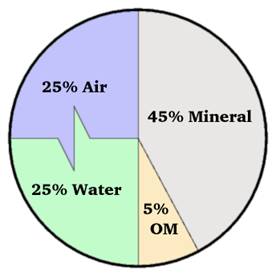
|
|||||
Soil Composition
The basic components of soil are minerals, organic matter, water and air. The typical soil consists of approximately 45% mineral, 5% organic matter, 20-30% water, and 20-30% air. These percentages are only generalizations at best. In reality, the soil is very complex and dynamic. The composition of the soil can fluctuate on a daily basis, depending on numerous factors such as water supply, cultivation practices, and/or soil type. Figure 1. Approximate composition of soil. The solid phase of soil, which includes minerals and organic matter, are generally stable in nature. Yet, if organic matter is not properly managed, it may be depleted from the soil. The liquid and gas phases of the soil, which are water and air respectively, are the most dynamic properties of the soil. The relative amounts of water and air in the soil are constantly changing as the soil wets or dries. |
|
 Soil composition is an important aspect of nutrient management. While soil minerals and organic matter hold and store nutrients, soil water is what readily provides nutrients for plant uptake. Soil air, too, plays an integral role since many of the microorganisms that live in the soil need air to undergo the biological processes that release additional nutrients into the soil.
Soil composition is an important aspect of nutrient management. While soil minerals and organic matter hold and store nutrients, soil water is what readily provides nutrients for plant uptake. Soil air, too, plays an integral role since many of the microorganisms that live in the soil need air to undergo the biological processes that release additional nutrients into the soil.